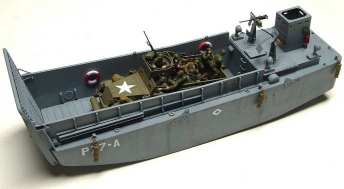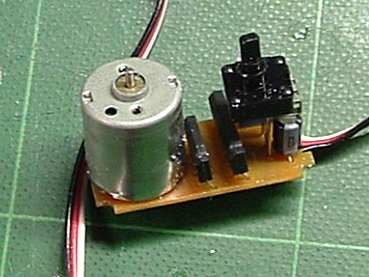
When I first heard that Trumpeter was coming out with a 1:35 LCM-3 landing craft, I knew I had to r/c it. I have a Lindberg 1:32 LCVP waiting in the wings, but it's REALLY small, and not a great quality model.
With 16 inches of waterline and about 4.5 inches beam, this is no 1:96 Missouri, but this fat-bottommed boat has lots of displacement- up to 35 ounces. Italeri also has an LCM-3 this year, but Trumpy's has a deeper hull... may or may not be correct, but it's good for displacement! Read a modeling review of the two at Perth Military Modeling.

Servo motor
First, what to power it with? I went with twin servo power. The electronic guts of a servo make a fair reversing ESC, with a bit of proportional control at small stick movement. The board can power it's own motor in direct drive, as shown here, or you can use any small 6v motor, say a 280 from a toy car.
Here the servo is mounted in bits of plastic. Motor has a 1.5mm shaft, which I mated to a 1/16" prop shaft running in brass tube. Connection was dicey as the motor's shaft is so short, but I found a heat shrink tube that when preshrunk would make a snug fit. After installing it, I shrunk another tube around it all for more grip.
| After first posting this, I was sent a tip by Tom Hynes
& Rich Long from the forum at the Marine Historical Society of
Detroit, http://www.mhsd.org . Members
often use servos to power HO scale tugs to push their 10 foot long lakers
around with. They mentioned that Northwest Shortlines ( http://www.nwsl.com
) has a series of u-joints for small locomotives, including some that can
be installed on 1.5mm shafts. See literature at http://www.nwsl.com/Catalog/cat-UJoint.pdf Thanks guys! |
Both motors installed. Alignment is important... the blocks around the motor were slightly adjustable in the supports, and were glued up after setting everything else in place. Note that the two pots on the servos need to be adjusted to give both motors zero rpm at neutral stick... put a drop of glue on their shafts to lock them in place.
Steering servo is simply set in place with some "Goop". Also used
Goop to seal the stuffing boxes.
bellcranks are cut from foam-core PVC board. It has some crush, so it presses
onto the rudder shafts snugly without any other mechanical lock. A drop of glue
will be good insurance.
Business end of the drive system.
Rudders have extensions Gooped on... the supports push out of the way for
installation, but I pinned them to the skegs with brass wire for strength.
Props are 3/4 inch, from a 1:350 Titannic. 2mm bore, so I installed a sleeve on
the 1/16" prop shafts and Gooped them together. Could also use 2mm
shafting, as many small motors have 2mm shafts too.
Props are counter-rotating, so I had to desolder one of the servo motors from
it's board, and reinstalled it "backwards", to get counter-rotation.
Plenty of power between these props and the servo drive, the boat scoots nicely.
Hatches.
The "steering deck" attaches with two screws into plastic tabs.
Underneath, the
receiver is set in place just ahead of the servos.
The poop is cut away from the main deck for rudder access, and attached with #2
socket head screws. These aren't hidden, but they don't look too obnoxious.
A section of the load deck is cut away for battery access. This compartment is a
perfect fit for four AA's.
Ballast
This model can take 35 ounces of total displacement (30 ton payload on the real
thing. By the way, no 32 ton Sherman tanks were landed in LCM-3's on D-Day,
despite the box's cover art. Trucks, light armor, or 60 men were more likely).
I put lead shot in the half track, almost a half pound there, and I still need
to load more ballast in the boat!
Sealing
The loading ramp can be glued to the sides of the hull (what, you expected me to
make an operating ramp? Hah!), but the hinged side is full of holes. I cheated
and laid in a bead of Goop there before painting.
No action shots yet- as I write this, it's about 5°F outside. Waiting for
spring!
Launch Date 4/15/2005
Finally took her outside to play. Breezy day, lightly ballasted, and the servo motors could barely hold their own! Steerage was fine downwind though.
Copyright 2004 Pat Matthews
e-mail me!